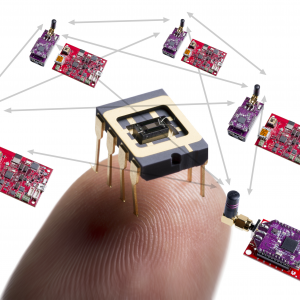Amsterdam ArenA and Holst Centre are teaming up to demo a distributed air quality monitoring (AQM) system at the Smart City Event (7–10 June) and Rihanna concert on 17 June. Based on Holst Centre’s innovative IoT sensor platform, the system’s network of multi-sensor nodes measures environmental conditions at various places from field to roof. Data is passed to the ArenA Innovations Room and can be used to fine tune the stadium’s climate. Besides improving spectator comfort throughout the ArenA, the IoT platform could enable many more innovative applications for the stadium of the future.
The ArenA seats over 53,000 spectators, and accommodate 68,000 people for concerts. The roof can be closed to fully protect the stadium during inclement weather, or reduce noise pollution and keep neighbors happy during late night events. Weather conditions, density of people and whether the roof is open or closed can all affect the environment in the stadium. And people can experience different conditions depending on where they are located, both around the stadium and between field level and the highest seats.
“Our number 1 priority is to ensure visitors to the ArenA have the best experience possible. A major factor in that is ensuring optimal environmental conditions and comfort levels for all fans. And we are actively exploring how innovation and technology can help us deliver that as part of our Amsterdam Innovations ArenA initiative. Partnering with Holst Centre on this testbed supports that vision,” said ArenA spokesperson.
The testbed features a wirelessly connected network of low-power multi-sensor nodes. Each node is capable of sensing many different parameters; this demo will focus on temperature, relative humidity and CO2 levels. The sensor data is relayed via a gateway to the internet and fed back to the control center in the ArenA Innovations Room. Here information can be displayed on screen as numbers, a graph or a map.
The system provides real-time air-quality information that allows mapping of locations with poor air-quality. It also acts as an early-warning system for decreasing air quality. Overall, the system is used to optimize comfort levels for people throughout the stadium. In a next step, the IoT sensor network can be opened up to innovators to test other applications for the stadium of the future.
“Environmental monitoring and its role in improving our comfort and health is a big issue for the world and a key research topic for us at Holst Centre. We have developed a modular and low-power platform for environmental monitoring over the Internet of Things that can be easily extended to measure a whole host of conditions including particulates and pollution, vibration, light intensity and more. Partnering with world famous names like the Amsterdam ArenA gives us the opportunity to put our technology to the test and demonstrate its potential,” said René Elfrink, project leader IoT testbeds at Holst Centre.
The implementation of the Holst Centre testbed in the stadium is part of the Amsterdam Innovation ArenA initiative. This unique initiative from the ArenA aims to accelerate the creation and market introduction of new and unique Smart City and Smart Stadium applications by focusing on key challenges such as profitability, sustainability, safety and customer experience. It provides an ideal launch pad for small and local companies to play in and access global markets for these emerging applications.
Visitors to June’s Smart City event have the opportunity to experience an interactive demo of the air monitoring system. During a guided tour, sensor nodes will be pointed out, while at the Innovation Room a screen will display the various data being collected. People in the room can also interact with an air quality sensor and see the effects instantly. During the Rihanna concert on June 17th, the technology will be put to the test to closely monitor environmental conditions with an expected audience of xx people in a closed roof setting.























